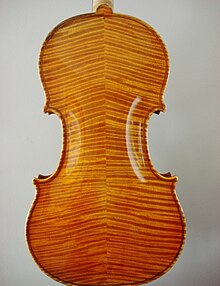Flame maple
This article needs additional citations for verification. (June 2008) |

Flame maple (tiger maple), also known as flamed maple, curly maple, ripple maple, fiddleback or tiger stripe, is a feature of maple in which the growth of the wood fibers is distorted in an undulating chatoyant pattern, producing wavy lines known as "flames". This effect is often mistakenly said to be part of the grain of the wood; it is more accurately called "figure", as the distortion is perpendicular to the grain direction. Prized for its beautiful appearance, it is used frequently in the manufacturing of musical instruments, such as violins and bassoons, and fine furniture. Another well-known use of the material is its use in guitars.
During the westward expansion of early settlers and explorers into the lands west of the Appalachian Mountains, curly maple was often used for making the stocks used on Kentucky rifles.
Workability
As previously mentioned, the structure of flame maple consists of distorted patterns found in the wood of specific maple trees. Although this pattern makes its appearance strikingly different from regular maple, they generally behave in a very similar way. When woodworking, one must consider the type of wood they are working with. Hard woods like oak require heavy-duty equipment to shape, while softwoods such as Pine can be cut and shaved with much less force and lighter tools. Maple woods fall under the hardwood category, though they are generally lighter and easier to work than stronger hardwoods like oak and mahogany.
As with most other woods, flame maple does have the potential to crack and splinter. To counter this, carpenters working with flame maple must use sharper, quicker tools over their heavier counterparts. Saw blades for example prove more effective against the flame maple when given a fine row of teeth instead of coarser, large teeth one may find on a blade used for oak. Flame maple, (and maple in general) is known for being stiff due to its tight grain pattern and solid structure, so applying too much stress to one side of the maple stock can result in fragmentation, and catastrophic failure. To prevent this, carpenters often use pre-shaped jigs to hold the maple in place.
Usage in Guitars
Popularization
Flame maple is especially popular in guitars, and has been for decades. Generally, the process includes cutting the maple to shape, forming it if necessary through mold-warping and applying a clear coat or lacquer to protect the finish, and ensure the wood holds its shape. Flame maple is especially popular, due to its inclusion on the Gibson Les Paul, particularly the one used by Slash, the iconic lead guitarist of Guns N Roses. As his fame increased so did the fame and value of this guitar style, prompting many guitar companies to provide similar flame-maple finishes thereafter.
Controversy
Among guitar communities, one debate always present is that of tonality. This is the debate on how much or how little the instrument's material affects its sound. While this is a massive debate in itself, flame maple is a hardwood which is generally regarded to produce a bright, shimmering sound, due to its rigidity and reflection against sound waves. This effect is generally noticeable in acoustic flame-maple guitars, but arguably insignificant in electric guitars. Additionally, the effects of clear-coating or applying nitro to a flame maple finish are also up for debate.
Variations
Figures on Gibson Les Paul Standard (1958-1960)

with light flame pattern
According to the Beauty Of The Burst by Yasuhiko Watanabe, the figures seen on the sunburst Les Paul are categorized into 8 types: 6 types of flame maple (Curly, Ribbon curly, Flame, Tiger stripe, Fiddleback, Pin stripe), and 2 other types (Blister and Bird's eye).[1] Note that usually the last two types are not considered as the flame maple variations, along with the quilt maple.
Figures on modern maple top guitars
- 6 types of flame maple wood
-
Curly
-
Ribbon curl
-
Flame
-
Tiger stripe
-
Fiddleback
-
Pin stripe
- Other types of figure maple wood (for comparison)
-
Blister
See also
Notes
- ^
Iwanabe, Yasuhiko (2012) [1996/1997, 1998/1999]. The Beauty Of The 'Burst: Gibson Sunburst Les Pauls from '58 to '60. Rittor Music / Hal Leonard Corp. p. 182. ISBN 978-4845602223 (Japanese paperback ed.), ISBN 978-0793573745 (English ed.).
STORY OF FIGURE - The Types of Figures Seen on the Sunburst Les Pauls: Flame, Tiger stripe, Tiger stripe, Curly, Fiddleback, Pin stripe, Ribbon curl, Blister, Bird's eye.
{{cite book}}:|work=ignored (help); External link in|quote=
External links
![]() Media related to Flamed maple wood at Wikimedia Commons
Media related to Flamed maple wood at Wikimedia Commons
![]() Media related to Flamed maple top guitars at Wikimedia Commons
Media related to Flamed maple top guitars at Wikimedia Commons
- ^ "Flame Maple - inSync". inSync. 2007-04-11. Retrieved 2018-11-27.









